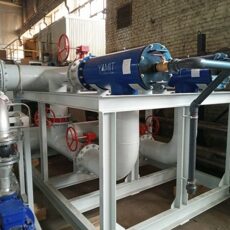Ultrafiltration units
The ultrafiltration process consists in passing the treated water through a membrane with a pore size of less than 0.1 microns, permeable to liquid, small molecules, ions and colloidal particles with sizes from 0.1 to 100 nm.
Water enters the membrane, which is a tube, the wall of which has capillaries capable of retaining fine impurities, algae, unicellular microorganisms, cysts, bacteria and viruses.
The full working cycle of the ultrafiltration unit consists of the following automated modes:
• Filtering,
• Hydraulic backwash,
• Backwash with the addition of chemical reagents (chemically enhanced washing).
The ultrafiltration process takes place in a dead-end mode. This means that no concentrate is drawn off, and contaminants accumulate on the membrane surface.
Periodically (every 40-60 min) in automatic mode, the blocks sequentially go to hydraulic backwash. For backwashing, filtered water is used, supplied by pumping stations.
During operation, salt and adsorbed deposits form on the membrane surface, as a result of which the pressure drop across the modules steadily increases. To combat adsorbed and mineral deposits, chemically enhanced flushes are used using chemical reagents supplied from dosing units.

